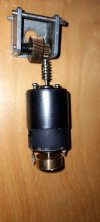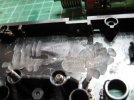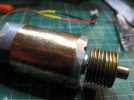So:
Looks like the original motor got hot. - Bulging block. From experience the motor fails by melting brushes/holder.
The block has been 'modified' to take a different motor. - Sort-of works. Probably not a fault of the motor?
The block is a little 'iffy'. - Chewed up mountings etc.
Even if we can get an original motor, they are not particularly good. We don't have the 'thrust-blocks' (I assume?).
I think (if I had a 3D printer):
I would look at making my own motor-block?
Possibly using the original wheels??
OR
Find another 'donor' on evilBay???
PhilP.
Looks like the original motor got hot. - Bulging block. From experience the motor fails by melting brushes/holder.
The block has been 'modified' to take a different motor. - Sort-of works. Probably not a fault of the motor?
The block is a little 'iffy'. - Chewed up mountings etc.
Even if we can get an original motor, they are not particularly good. We don't have the 'thrust-blocks' (I assume?).
I think (if I had a 3D printer):
I would look at making my own motor-block?
Possibly using the original wheels??
OR
Find another 'donor' on evilBay???
PhilP.



